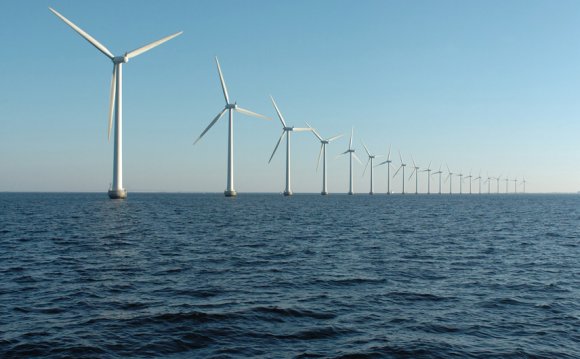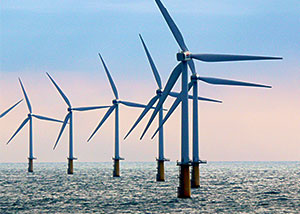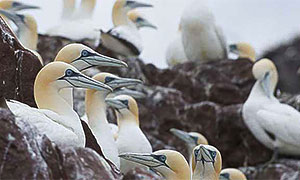
 Thousands of white-winged gannets soared above the cliffs as our boat circled the Bass Rock. The island, a steep-side volcanic edifice off the east coast of Scotland, is home each year to the world’s largest colony of northern gannets (Morus bassanus). More than 150, 000 birds nest on an island of three hectares — or five birds per square meter. Since the birds have a wingspan not far short of two meters, that makes for cramped
Thousands of white-winged gannets soared above the cliffs as our boat circled the Bass Rock. The island, a steep-side volcanic edifice off the east coast of Scotland, is home each year to the world’s largest colony of northern gannets (Morus bassanus). More than 150, 000 birds nest on an island of three hectares — or five birds per square meter. Since the birds have a wingspan not far short of two meters, that makes for cramped
Ad Meskens/Wikimedia Commons
Princess Amalia Wind Farm in the North Sea, off the Netherlands coast, is comprised of 60 turbines.
largest utility. Other big players in the North Sea include Masdar, the Abu Dhabi government’s renewable energy company.
Although no longer about local empowerment, offshore wind has at least appeared to be environmentally benign. But while nobody doubts its credentials for producing low-carbon energy, the presumption that offshore wind is no threat to wildlife is increasingly being questioned. There are concerns especially about construction noise frightening marine mammals over wide areas of ocean, and about the threat that huge working farms may sometimes pose to birds.
The latter concern applies especially off Scotland, which is home to 45 percent of the European Union’s breeding seabirds. They live at staggering densities on cliff faces and volcanic islands, such as the Bass Rock, and travel long distances to forage for food around the offshore sand banks whose shallow waters also attract wind farm developers.
For this reason, the U.K.’s Royal Society for the Protection of Birds (RSPB), which has largely supported the hundreds of smaller wind farms on hilltops across Scotland, has opposed almost all the offshore plans to date. It says that while onshore wind farms rarely damage birds, badly sited offshore farms are unlikely to be so benign.
The concerns are shared, if more quietly, by government scientists. Last July, three months before ministers approved the plans for Inch Cape and the three other wind farms off Edinburgh, the Joint Nature Conservation Committee, which advises the British government, set boundaries for three marine protected areas off east Scotland that substantially overlap the wind-farm zones. And it proposed that the banks receive tougher protection under the EU Birds Directive. The committee listed renewable energy as an activity “capable of affecting the protected features of the
Conservationists say that in the rush to offshore wind, not enough research has been done on the risks. site, ” and noted, “We have an international responsibility to protect [seabirds] around Scotland.” Yet the wind farms still got the go-ahead.
 That apparent policy conflict is one reason why the RSPB has mounted a legal challenge to the government for failing to uphold conservation law when granting approval for the farms. Judicial hearings will begin in late May.
That apparent policy conflict is one reason why the RSPB has mounted a legal challenge to the government for failing to uphold conservation law when granting approval for the farms. Judicial hearings will begin in late May.
The conservationists’ case is that in the rush to put wind farms offshore, not enough research has been done to ascertain the risks. “There are half a million seabirds in this area. Nowhere in Europe are there such internationally important seabird colonies so close to such major wind farms, ” says Brock.
At Inch Cape Wind, Kerr is frustrated at the challenge. “The project will have an overall positive environmental impact and will help address climate change — one of the biggest threats to seabird species in Scotland, ” he told me.
The RSPB says compromises with the industry are possible. The problem is that the research to find places for wind farms that are safe for birds has not been done. When correctly sited, research indicates, offshore wind farms need not damage wildlife. Han Lindeboom of Wageningen University has found that the first Dutch offshore wind farm, completed in 2007, showed no damage to life on the seabed between the turbine foundations. Some fish and porpoises even congregated among the turbines, finding shelter where fishing boats and most other shipping is banned.
But birds and rotating turbine blades are not an easy match, especially when large turbine farms block access to places full of food. Off Denmark, sea ducks have all but disappeared from the vicinity of one wind farm. Plans to extend the London Array were abandoned last year amid concerns that such an expansion would threaten red-throated divers, Arctic birds that spend the winter in the Thames estuary.
Back at the Bass Rock, our guide pointed out the remains of a medieval monastery and a prison that once led to the rock being dubbed “Scotland’s Alcatraz, ” as well as the still-functioning lighthouse. But the gannets are the only inhabitants now. They have reached record numbers in recent years and are a riveting spectacle both from tourist boats and on images provided by island webcams operated by visitors at the Seabird Centre.
But can they — and the big colonies of puffins, kittiwakes, and other seabirds on neighboring volcanic islands — survive the arrival of a fleet of
ALSO FROM YALE e360
After years of delays and legal battles, several offshore wind projects seem poised to be launched off the U.S. East Coast. But the lack of stable government incentives and tax credits may continue to hobble an industry that already has a strong foothold in Europe.
READ MOREgiant wind turbines on feeding grounds as few as 20 kilometers away?
Ewan Wakefield at the University of Glasgow, who has carried out satellite tracking of the foraging ranges of the Bass Rock gannets, says that “a good proportion of them pass through the wind farm area when they go to feed. And they forage at turbine height.” Sarah Wanless, of the U.K. government’s Centre for Ecology and Hydrology at nearby Penicuik, says the four wind farms “could effectively block two-thirds of [the gannets'] access to the open sea.”
The birds could prove smart enough to avoid collisions and find food elsewhere. Some already forage for food as far away as Norway. But long-distance travel may leave them less able to raise their chicks. “In the worst case, the very viability of the Bass Rock as a gannet colony could be under threat, ” says Brock. “Major decisions are being taken without reliable projections of the impacts.”
But Europe is set on harvesting the North Sea winds for low-carbon energy, to help create a stable climate where gannets as much as anything else can thrive. With the stakes so high, will a seabird colony end up as collateral damage?
ABOUT THE AUTHOR
Fred Pearce is a freelance author and journalist based in the U.K. He serves as environmental consultant for New Scientist magazine and is the author of numerous books, including The Land Grabbers. Previously for Yale Environment 360, he has written about the challenges of establishing a global carbon budget and conservation efforts for Kenya's mountain forests.
Energy Landscapes: An Aerial View
Of Europe’s Carbon Footprint
Europe and the United States have very similar standards of living, but significantly different carbon footprints. Aerial photographer Alex MacLean documents this phenomenon in images that show how Northern Europe uses smart design and planning to reduce the amount of carbon it emits.
RELATED VIDEO












